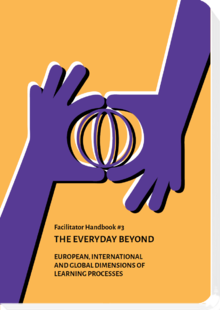Difference between revisions of "The Everyday Beyond"
| Line 1: | Line 1: | ||
<div class="left-column-contentinner"> | <div class="left-column-contentinner"> | ||
| + | <div class=teaser-text>European, international and global dimensions of learning processes.</div> | ||
<div style="border:3px solid white; background: #eee; width:33%;padding:10px; min-width:180px; min-height:550px; margin-right:20px; float:left;" > | <div style="border:3px solid white; background: #eee; width:33%;padding:10px; min-width:180px; min-height:550px; margin-right:20px; float:left;" > | ||
[[File:Everyday-beyond-book-cover.png | 220px]] | [[File:Everyday-beyond-book-cover.png | 220px]] | ||
| Line 13: | Line 14: | ||
-out of stock- | -out of stock- | ||
</div> | </div> | ||
| − | < | + | <gallery> |
| + | File:Everyday-beyond-book-cover.png | ||
| + | File:Eb-book-1.png | ||
| + | File:Eb-book-2.png | ||
| + | File:Eb-book-3.png | ||
| + | File:Eb-book-4.png | ||
| + | File:Eb-book-5.png | ||
| + | </gallery> | ||
The development of a globalised world and intensified European cooperation brought about a lot of movement in terms of goods. People are moving more – because of their needs, struggles, or for pleasure. Thus, even in everyday routines we are already embedded in a global context – we are global citizens. Objects, ideas, people from “beyond everyday,” from beyond our city, region or even state contribute and shape our daily lives and our opportunities. As global humans, we talk about global issues with our friends and families, and as facilitators, teachers and trainers to children, youth or adult learners. Hardly any of the issues we work on can be fully understood without addressing the global connections behind them. | The development of a globalised world and intensified European cooperation brought about a lot of movement in terms of goods. People are moving more – because of their needs, struggles, or for pleasure. Thus, even in everyday routines we are already embedded in a global context – we are global citizens. Objects, ideas, people from “beyond everyday,” from beyond our city, region or even state contribute and shape our daily lives and our opportunities. As global humans, we talk about global issues with our friends and families, and as facilitators, teachers and trainers to children, youth or adult learners. Hardly any of the issues we work on can be fully understood without addressing the global connections behind them. | ||
This handbook is designed to support you in including the global, the international and the European perspectives in your educational work. It offers a variety of opportunities to interlace these perspectives in your daily work as a teacher, tutor, trainer, facilitator, group leader, educator, or a volunteer in civic initiatives. | This handbook is designed to support you in including the global, the international and the European perspectives in your educational work. It offers a variety of opportunities to interlace these perspectives in your daily work as a teacher, tutor, trainer, facilitator, group leader, educator, or a volunteer in civic initiatives. | ||
| − | <hr | + | |
| + | <hr class=simpleline> | ||
| + | '''From the Table of Content:''' | ||
| + | <div class="mw-collapsible mw-collapsed" data-expandtext="Read more"> | ||
'''From the Table of Content:''' | '''From the Table of Content:''' | ||
*How global, international and European learning contributes to competency development | *How global, international and European learning contributes to competency development | ||
| Line 24: | Line 35: | ||
*Global dimension | *Global dimension | ||
* Outlook | * Outlook | ||
| + | </div> | ||
| + | |||
<hr class=simpleline> | <hr class=simpleline> | ||
| − | + | ||
| − | |||
| − | |||
| − | |||
| − | |||
| − | |||
| − | |||
| − | |||
Revision as of 20:33, 15 January 2019
Handbooks for Facilitators #3
Editors: M. Haberl, J. Teynor, N. Zimmermann, M. Prahl
Design: S. Georgiev
Download: PDF
-out of stock-
The development of a globalised world and intensified European cooperation brought about a lot of movement in terms of goods. People are moving more – because of their needs, struggles, or for pleasure. Thus, even in everyday routines we are already embedded in a global context – we are global citizens. Objects, ideas, people from “beyond everyday,” from beyond our city, region or even state contribute and shape our daily lives and our opportunities. As global humans, we talk about global issues with our friends and families, and as facilitators, teachers and trainers to children, youth or adult learners. Hardly any of the issues we work on can be fully understood without addressing the global connections behind them.
This handbook is designed to support you in including the global, the international and the European perspectives in your educational work. It offers a variety of opportunities to interlace these perspectives in your daily work as a teacher, tutor, trainer, facilitator, group leader, educator, or a volunteer in civic initiatives.
From the Table of Content:
From the Table of Content:
- How global, international and European learning contributes to competency development
- European dimension
- International dimension
- Global dimension
- Outlook
- Steps toward action
- Holistic learning
- The Everyday Beyond
- Creativity Handbook
- Facilitation step-by-step
Contact
Support
This toolbox has been produced with the financial assistance of the European Union. The contents of this document are the sole responsibility of the implementing partner organisations and can under no circumstances be regarded as reflecting the position of the European Union.









